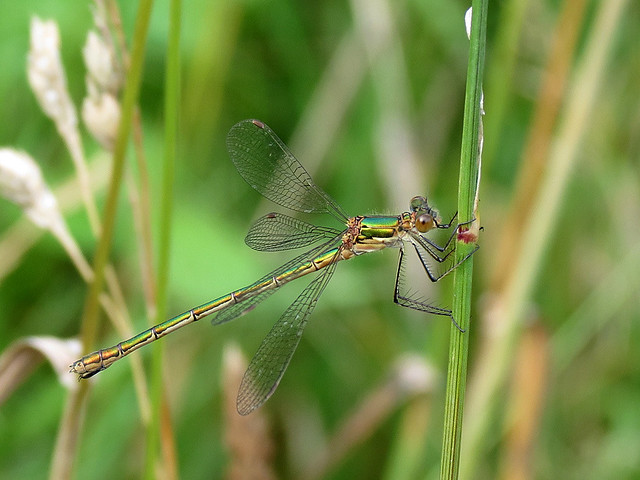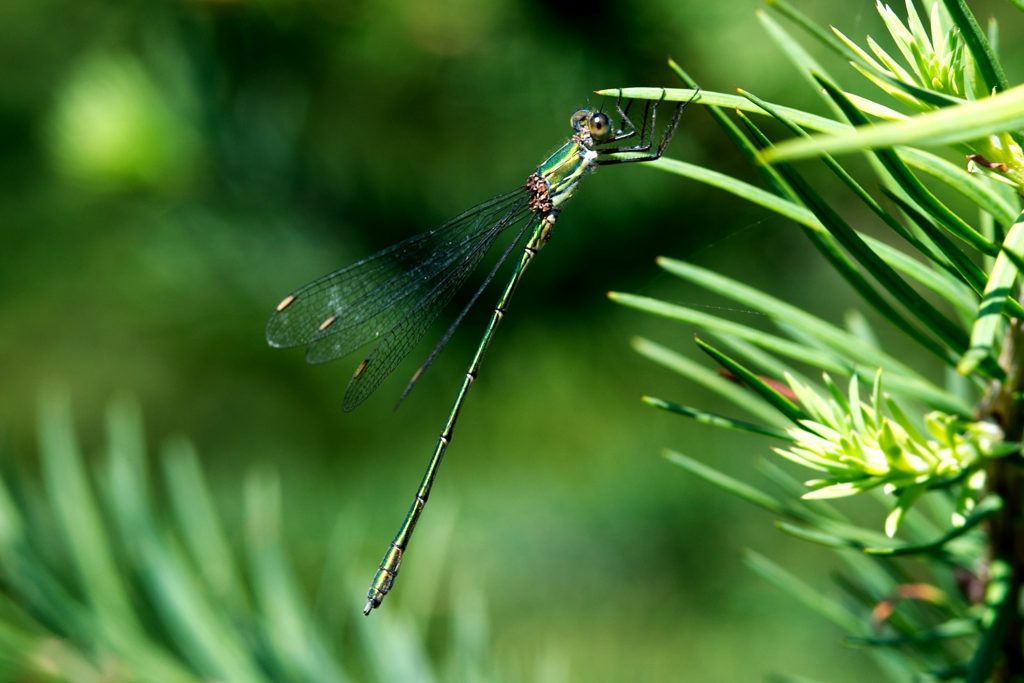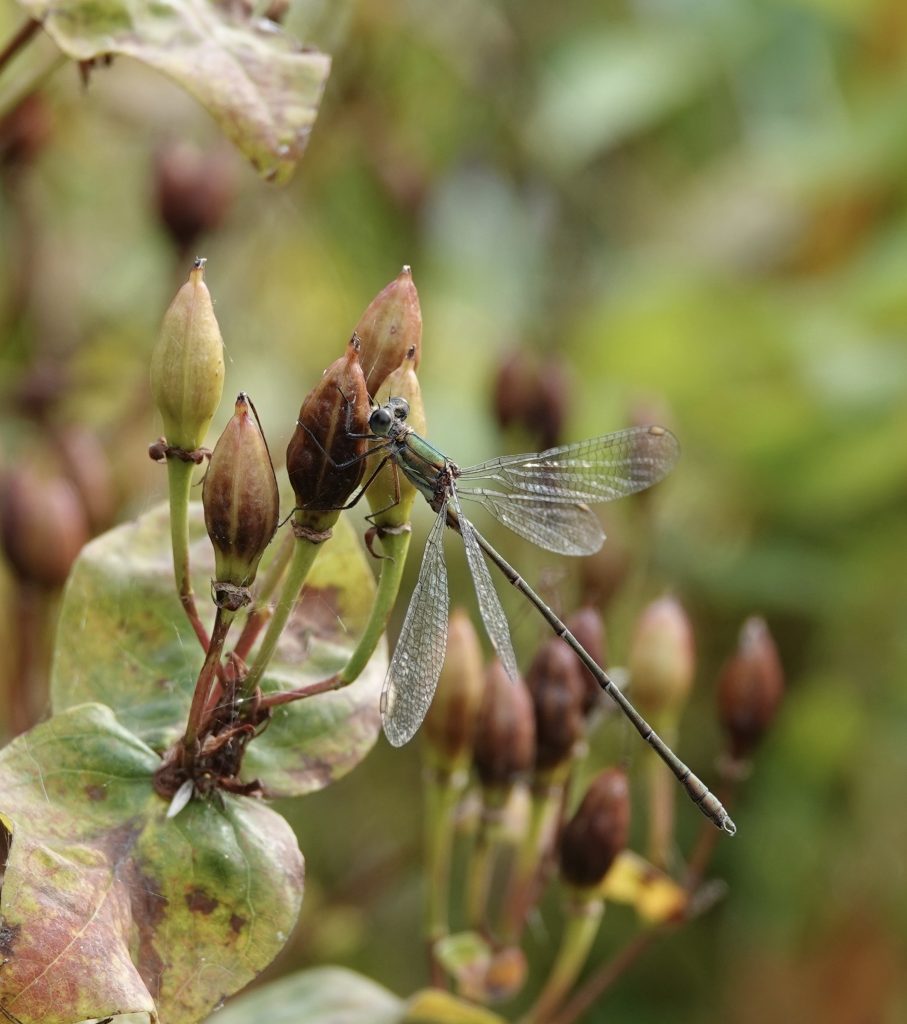<-Previous Species – Next Species->
A mainly scarce migrant, though regular at some key sites may suggest local breeding.
Flight Period
Distribution Map
www.yorkshiredragonflies.org.uk
<-Previous Species – Next Species->
A mainly scarce migrant, though regular at some key sites may suggest local breeding.
<-Previous Species – Next Species->
45-48mm; Wingspan: Male 61mm; Female 65mm; Hindwing 27-36mm; Larva: 30-40mm
Translucent wings with a broad, dark iridescent blue-black band on outer part of both wings, there is no pterostigma. Body is metallic blue-green. Immatures wing band is dark brown.
Translucent pale green wings, white ‘false pterostigma’, larger on forewing than hindwing, metallic green body. Sometimes androchrome females are observed (male coloured females), these can be identified by the ‘false pterostigma’ which males lack.
Males are territorial, though large numbers can be found together. They attract females by flicking their wings open whilst performing an aerial dance in front of them, flopping down on to the egg-laying site. Females stay away from water unless looking for a mate or egg-laying. Adults will make use of nettle beds and tall grasses to rest.
Mature, slow-flowing streams, rivers and canals, with muddy sediment. Can overlap with Beautiful Demoiselle where habitat contains patches of sand and gravel. Prefers open banksides, where as Beautiful Demoiselle will happily use shady areas. Adults of both sexes can be found well away from water and ponds where breeding is unlikely, thought they will breed in lakes adjacent to rivers. Sensitive to waterway management (clearance of vegetation) and pollution.
Abundant along occupied rivers and streams.
<-Previous Species – Next Species->
35-39mm; Wingspan: Male 42mm; Female 45mm; Hindwing 19-22mm

Metallic green in colour. This species has a slow maturation period of two to four weeks, over this period a blue pruinescence appears on the thorax between wings and segments 1,2, 9 and 10. Eyes blue. Confusion species is Scarce Emerald Damselfly which is extinct in Yorkshire. Both sexes rest with wings half open.

Metallic green, with pale beige sides to the thorax. Distinctly thicker abdomen than male.
Weak flyer usually remaining close to emergent vegetation, rarely going far over water. Copulation usually takes place close to breeding site and last from 30 minutes to over an hour. Females usually arrive to oviposit in tandem with the male. Oviposits in to stems of emergent grasses, rushes, sedges and horsetails, usually above surface, but can submerge, including the male. Fairly sedentary and can be absent from seemingly good sites.
Still or slow moving water such as ponds, bogs, ditches, canals and lake edges with dense emergent vegetation. Tolerates brackish and acidic water. Sensitive to excessive clearance of emergent vegetation.
Found at many sites through all Vice-counties.
<-Previous Species – Next Species->
A recent colonist, the first record in 2019 coming from Harwood Dale, North Yorkshire.
 First record for Yorkshire at Harwood Dale, courtesy of Steve Beevers
First record for Yorkshire at Harwood Dale, courtesy of Steve Beevers
 Photo courtesy of Keith Gittens
Photo courtesy of Keith Gittens
<-Previous Species – Next Species->
33-36mm; Wingspan: Male 44mm; Female 48mm; Hindwing 19-24mm
The only red damselfly in Yorkshire and unlikely to be mistaken for anything else. Red abdomen, with black bands on segments 7 to 9. Thorax is black on the top with a red stripe (yellow in immatures). Black areas have a bronze tint.
Male
Occurs in three colour forms. The commonest form is typica, with black bands on most segments of the abdomen. Fulvipes is less well marked than typica and closely resembles the male. Melanotum is a dark from being mainly black, however the antehumeral stripes remain yellow (only yellow when immature in other forms).
Female – typica
This is the first damselfly to emerge each year in Yorkshire. It has a synchronous emergence, all emerging within a three week period, it is therefore shortly after emergence that this species is most abundant. Males emerge slightly earlier than females and also mature more quickly. Copulation lasts for around 15-20 minutes. Eggs are laid in tandem, the female may submerge taking the male with her. The life cycle is two years, on initially occupying a new site there may therefore only be adults found every other year.
Has a wide habitat tolerance, including brackish and slightly polluted water, though avoids fast flowing water. Higher abundance in well vegetated, standing water.
Evenly distributed across VC61-64, scarcer in VC65.
<-Previous Species – Next Species->
33-37mm; Wingspan: Male 43mm; Female 46mm; Hindwing 19-24mm
Mainly bronzed black with bright red eyes. Top of thorax lacking any antehumeral stripes. Segments 1, 9 and 10 are blue. Sides of thorax are blue with black line and spur present. Legs are black. Immature male is similar to female. Similar to Small Red-eyed Damselfly which is smaller, differences occur in the blue markings. At rest the wing tips reach in to segment eight, in Small Red-eyed Damselfly the wing tips only reach as far as segment 6 or 7. Generally holds its abdomen level, where as Small Red-eyed Damselfly often holds its abdomen slightly upcurved towards the end.
Mainly black with green sides to thorax containing black line and spur. Segments 9 and 10 are black with narrow blue divisions. Eyes are a dull red colour. Usually have short shoulder stripes, though some lack them all together and some may form as explanation marks.
Strong direct flight over water. Spend lots of time resting on broad floating leaves such as water lilies. Mats of algae and debris are also used and males may use surrounding shrubs if there is little floating vegetation. After emergence they will spend time away from water to mature. The first three weeks of emergence is probably the best time to encounter this species at close quarters. Females usually only appear at water to breed. Copulation takes place over water or on nearby vegetation. Egg laying is mainly in tandem, both sexes often submerging. They are laid mainly on the underside of Water Lilies, though other floating vegetation will be used.
Preference for larger ponds, lakes and canals. Requires abundant floating vegetation, such as water-lilies Nymphaceae, or broad-leaved pondweed Potamogeton natans. When these are absent it may use floating algae mats, or rest on bankside vegetation.
Species is at the northern edge of its range in Yorkshire.
<-Previous Species – Next Species->
29mm; Wingspan: Male 38mm; Female 38mm; Hindwing 16-20mm
Similar to Red-eyed Damselfly though distinctly smaller, more likely to be overlooked as Blue-tailed Damselfly. Lacks spots behind the eyes which are reddish-brown. Pale brown pterostigma. Black top to thorax with thin, broken antehumeral stripes. Thorax side is blue with a ‘Spur’ often ending in a spot. Underside of legs are pale. Abdomen dark on top except for S1, S9- S10 and sides of S2-S3 and S8 which are blue. S10 has a black mark, rather like an X, on the top. Wing tips just reach past the join of segment 6 and 7, Red-eyed Damselflies reach into segment 8. Often holds it’s abdomen slightly upcurved, Red-eyed Damselflies hold their abdomen level.
Lack spots behind the eyes. Pale brown pterostigma. Black top to thorax with complete antehumeral stripes. Thorax side is blue-green. Abdomen is predominantly black with a wedge of colour on S10.
During the day males appear constantly active, patrolling well away from the margin in search of females. Once copulation has taken place, they oviposit in tandem into stems and leaves of floating vegetation. They can often submerge for long periods of time. Larvae live among submerged water plants and emerge after one year on to floating vegetation.
Ponds, lakes and ditches with plenty of floating vegetation such as Hornwort Ceratophyllum, Water-milfoil Myriophyllum and Waterweed Elodea. Also uses rafts of floating algae. Generally found in sheltered positions, with nearby trees and shrubs for roosting. Will tolerate brackish conditions.
<-Previous Species – Next Species->
29-34mm; Wingspan: 35-40mm; Hindwing 14-21mm
Dark bronze-black metallic with blue segment 8. Blue or green sides to the thorax and antehumeral stripes. Blue eye spots. Pterostigma is distinctive being bi-coloured black and white. Tips of the lower appendages diverge.
Occur in several colour forms dependent on age. Segment 8, though not always blue, is usually clearly different from the other sections. Start as either rufescens with a reddish-pink thorax and blue segment 8 or violacea with a violet thorax and antehumeral stripes, black humeral stripes and blue segment 8. After around eight days they mature and change colour, rufescens become greenish-brown of the form rufescens-obsoleta. The form violacea mature into two separate from. The first is infuscans which is a pale green colour, and retaining the black humeral stripes. The second is an andromorph form which adopts the same colours as a male.
Often found in marginal vegetation in large numbers. Copulation last from between two to six hours, due to this, it is the most frequently observed species seen in the wheel position. Often females selected by the males are still in their immature colour forms. Females oviposit alone onto the tissue of aquatic plants and debris, where they are not usually harassed by the males. Frequently found in dull weather when other species are inactive. Larvae emerge after one to two years.
Wide range including garden ponds, lakes, rivers, canals and ditches. Can also be found in brackish conditions and acidic peaty pools. More tolerant of pollution than other species, only really avoiding fast-flowing water. Readily disperses and is one of the first species to colonise new sites.
Common and widespread throughout the area.
<-Previous Species – Next Species->
<-Previous Species – Next Species->
33mm, Wings 36-44mm
Bright blue body with black markings; thorax black top with 2 thin antehumeral stripes; abdomen black U-shaped mark segment 2, segment 8 blue and 9 marked black; eyes bright spots not joined by a bar.
2 colour forms:-
1) Body green with black markings on upper surface; segment 2 with black thistle shape.
2) Blue form has “mercury” shape on segment 2; rest of black upper markings are more extensive; narrow pale antehumeral stripes.
Note: The shape of the pronotum is the only conclusive way to seperate this species from Variable Damselfly. Personal observations have highlighted that female Azure Damselflies lack the bar between the eye spots, compared to Variable Damselfly.
Initially this species is more abundant than the similar Common Blue Damselfly with which it can be easily confused. It is easy to make the mistake of identifying early blue damselflies as being Azure, then assuming on later visits that this is still the case. However after four of five weeks, Azure can suddenly become harder to find as Common Blue Damselfly become more abundant.
Wide range of habitats from garden ponds, lakes, ditches, streams, canals and rivers to peaty pools. The main requirement is plenty of marginal vegetation in sheltered locations. Frequently settles on floating vegetation, as well as being readily found in adjacent grasslands and sheltered woodland edges.
Not territorial. Copulation is prolonged on warm sunny days. Pairs oviposit in tandem into soft plant tissue, often submerging to do so. Larvae live among submerged vegetation and emerge after one year. Emergence takes place on marginal vegetation or flower spikes in the centre of water bodies. Females emerge first, followed a few days later by the males.
Common
<-Previous Species – Next Species->
23-30mm; Wingspan: Male 42mm; Female 42mm; Hindwing 16-23mm
Coenagrion Spur’ on side of thorax, also present on Azure Damselfly, but absent on Common Blue Damselfly. Antehumeral stripes are usually broken, sometimes they can be absent or complete. Wine glass marking on segment two of the abdomen. Segment nine contains a square with three points (three pointed crown). Overall appears more slender and darker than the similar Azure Damselfly. Can be confirmed by the strongly trilobate margins of the pronotum.
‘Coenagrion Spur’ on side of thorax, also present on Azure Damselfly, but absent on Common Blue Damselfly. Antehumeral stripes are usually complete. Black thistle shape on segment two. Blue form, blue on top of the abdomen. Dark form, similar to Azure Damselfly is not as numerous. Overall appears bluer than the similar Azure Damselfly.
Note: The shape of the pronotum is the only conclusive way to seperate this species from Azure Damselfly. Personal observations have highlighted that female Variable Damselflies have a bar between the eye spots, which is absent in Azure Damselfly.
Males are none territorial. Copulation last around 10-15 minutes. Once copulation has taken place the pair will oviposit in tandem, into stems of floating water plants, or remains of rushes and common reed. The larvae develop in one year living among submerged vegetation.
Fens, ponds, lakes, slow-flowing dykes, canals and peaty pools. Dependant on plenty of emergent vegetation. After emergence, tenerals require sheltered areas to mature, often being found in adjacent grasslands and in the lee of shrubbery and hedgerows.
After a tentative report in 2006, now confirmed as being present in East Yorkshire. Currently restricted to the Broomfleet Washlands complex. This is currently the only species present in Yorkshire that is of national importance due to its near threatened status.